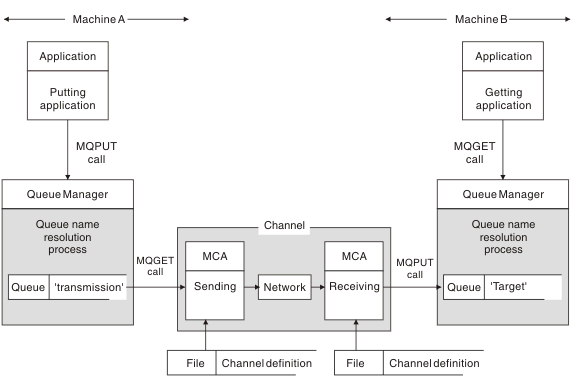Queue name resolution
This topic contains information about queue name resolution as performed by queue managers at both sending and receiving ends of a channel.
- Applications do not need to make routing decisions
- Applications do not need to know the network structure
- Network links are created by systems administrators
- Network structure is controlled by network planners
- Multiple channels can be used between nodes to partition traffic

- The application putting the message issues MQOPEN and MQPUT calls to put messages on the target queue.
- The application getting the messages issues MQOPEN and MQGET calls to get the messages from the target queue.
If both applications are connected to the same queue manager then no inter-queue manager communication is required, and the target queue is described as local to both applications.
However, if the applications are connected to different queue managers, two MCAs and their associated network connection are involved in the transfer, as shown in the figure. In this case, the target queue is considered to be a remote queue to the putting application.
- The putting application issues MQOPEN and MQPUT calls to put messages to the target queue.
- During the MQOPEN call, the name resolution function detects that the target queue is not local, and decides which transmission queue is appropriate. Thereafter, on the MQPUT calls associated with the MQOPEN call, all messages are placed on this transmission queue.
- The sending MCA gets the messages from the transmission queue and passes them to the receiving MCA at the remote computer.
- The receiving MCA puts the messages on the target queue, or queues.
- The getting application issues MQOPEN and MQGET calls to get the messages from the target queue.
The combination of sending MCA, the network connection, and the receiving MCA, is called a message channel, and is inherently a unidirectional device. Normally, it is necessary to move messages in both directions, and two channels are set up for this movement, one in each direction.